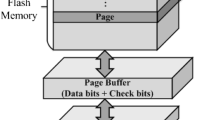Abstract
Disturb faults are considered one the most important failure modes in non volatile memories. Disturb faults are highly dependant on the core memory cell structure, manufacturing technology, and array organization. In this paper, we analyze the origins of such disturbs and propose a method that uses cell structure and array organization information to identify the relevant disturbs and to create a reduced fault list. To demonstrates its effectiveness, the method was used to create minimized fault lists for NOR and NAND flash memory arrays. Moreover, we show how the reduced fault list developed can be used to devise more efficient test algorithms.
Similar content being viewed by others
References
Z. Al-Ars and A. van de Goor, “Static and Dynamic Behavior of Memory Cell Array Spot Defects in Embedded DRAMs,” IEEE Trans. Comput., vol. 52, no. 3, pp. 293–309, March 2003.
A. Brand, K. Wu, S. Pan, and D. Chin, “Novel Read Disturb Mechanism Induced by Flash Cycling,” Proc. Int. Reliab. Phys. Symp., 1993, pp. 127–132.
W. Brown and J. Brewer, Nonvolatile Semiconductor Memory Technology: A comprehensive Guide to Understanding and Using NVSM Devices New York: IEEE, 1998.
M.L. Bushnell and V.D. Agrawal, Essentials of Electronic Testing for Digital, Memory and Mixed-signal VLSI Circuits, Norwell, MA: Kluwer, 2000.
K.-L. Cheng, J.-C. Yeh, C.-W. Wang, C.-T. Huang, and C.-W. Wu, “RAMSES-FT:A Fault simulator for Flash Memory Testing and Diagnostics,” Proc. VLSI Test Symp., 2002, pp. 281–286.
S.-K. Chiu, J.-C. Yeh, C.-T. Huang, and C.-W. Wu, “Diagonal Test and Diagnostic Schemes for Flash Memories,” Proc. Int. Test Conf., 2002, pp. 37–46.
K.R. Hoffman, C. Werner, W. Weber, and G. Dorda, “Hot-Electron and Hole Emission effects in Short n-Channel MOSFET’s,” IEEE Trans. Electron Devices, vol. 32, no. 3, pp. 691–699, March 1985.
IEEE 1005 Standard Definitions and Characterization of Floating Gate Semiconductor Arrays, 2nd ed., Piscataway: IEEE Standard Department, 1999.
M. Lenzlinger and E.H. Snow, “Fowler–Nordheim Tunneling in Thermally Grown SiO2,” J. Appl. Physi., vol. 40, no. 1, pp. 278–284, 1969.
M.G. Mohammad and K.K. Saluja, “Simulating Program Disturb Faults in Flash Memories Using SPICE Compatible Electrical Model,” IEEE Trans. Electron Devices, pp. 2286–2291, November 2003.
M.G. Mohammad and L. Al-Terkawi, “Fault Collapsing for Flash Memory Disturb Faults,” Proc. 10th Eur. Test Symp., May 2005, pp. 142–147.
M.G. Mohammad and K.K. Saluja, “Optimizing Program Disturb Faults Test Using Defect-Based Testing,” IEEE Trans. CAD Integr. Circuits Syst., vol. 24, no. 6, pp. 905–915, June 2005.
M.G. Mohammad, K.K. Saluja, and A. Yap, “Fault Models and Test Procedures for Flash Memory Disturbances,” J. Electron. Test: Theory Appl., vol. 17, no. 6, pp. 495–508, December 2001.
P. Pavan, R. Bez, P. Olivo, and E. Zanoni, “Flash Memory Cells—An Overview,” Proc. IEEE, vol. 85, no. 8, pp. 1248–1271, August 1997.
B. Riccò, M. Lanzoni, A. Manstretta, H.E. Maes, D. Montanari, and A. Modelli, “Nonvolatile Multilevel Memories for Digital Applications,” Proc. IEEE, vol. 86, no. 12, pp. 2399–2421, December 1998.
S. Satoh, G. Hemink, K. Hatakeyama, and S. Aritome, “Stress Induced Leakage Current of Tunnel Oxide Derived from Flash Memory Read–Disturb Characteristics,” Proc. Int. Conf. Microelectron. Test Struct., vol. 8, March 1995, pp. 97–99.
A. Silvagni, G. Fusillo, R. Ravasio, M. Picca, and S. Zanardi, “An Overview of Logic Architectures Inside Flash Memory Devices,” Proc. IEEE, vol. 91, no. 4, pp. 569–580, April 2003.
J. van de Goor, Testing Semiconductor Memories: Theory and Practice, Gouda, The Netherlands: ComTex, 1998.
A. van de Goor and Z. Al-Ars, “Functional Memory Faults: A Formal Notation and a Taxonomy,” Proc. 18th IEEE VLSI Test Symp., 2000, pp. 281–289.
G. Verma and N. Meilke, “Reliability Performance of the ETOX Based Flash Memories,” Proc. Int. Reliab. Phys. Symp., 1988, pp. 158–166.
J.-C. Yeh, C.-F. Wu, K.-L. Cheng, , Y.-F. Chou, C.-T. Huang, and C.-W. Wu, “Flash Memory Built-in-self-test Using March-like Algorithms,” Proc. 1st Int. Workshop Electron. Des., Test, Appl. (DELTA’02), 2002, pp. 137–141.
Author information
Authors and Affiliations
Corresponding author
Additional information
Editor: K. K. Saluja
This work was supported by Kuwait University Research Grant Number EO 01/04.
Rights and permissions
About this article
Cite this article
Mohammad, M.G., Terkawi, L. Techniques for Disturb Fault Collapsing. J Electron Test 23, 363–368 (2007). https://doi.org/10.1007/s10836-006-0629-6
Received:
Published:
Issue Date:
DOI: https://doi.org/10.1007/s10836-006-0629-6




